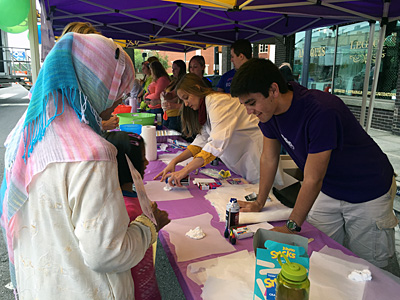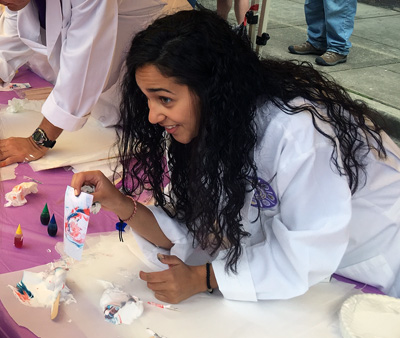Introduction
The experiment demonstrates the interactions between hydrophobic and hydrophilic substances. Hydrophobic substances repel water – the name comes from the Greek word, “Hydros”, for water, and, “phobos”, for fear. Hydrophilic substances (the Greek stem, “philic”, means “love”) attract, or love, water.
A polar molecule has a separation of positive and negative charges, while a non-polar molecule has no areas of prevalent positive or negative charges (it is neutral). Water is a polar molecule, having positive charge around the hydrogen and a negative charge around the oxygen. Because water is polar, other polar molecules will be attracted to it; these are the molecules we describe as hydrophilic. Conversely, hydrophobic molecules are non-polar/non-charged.
Soap molecules are very interesting in that they contain both hydrophobic portions and hydrophilic portions. We refer to these molecules as AMPHIPATHIC. These molecules typically have a polar head and a long, hydrophobic tail. Shaving cream is a foam consisting of molecules of soap and air.
Food coloring consists of dye molecules that are dissolved in water, so they must be hydrophilic. When these dyes are added to shaving cream, the dye molecules can only interact with the polar heads of the soap molecules, and not with the hydrophobic tails. This therefore limits their mobility. Molecules in paper are composed of molecule of cellulose (a polymer of glucose). Cellulose contains multiple polar hydroxyl functional groups that can interact readily with water, so paper is very hydrophilic. Because both the food coloring dyes and paper molecules are hydrophilic, they will interact readily with one another and the dyes will spread easily across the paper to form very colorful patterns in a much different way than they interacted with the shaving cream. This creates a marbling effect on the paper that is clearly distinct from the pattern seen on the shaving cream.
Materials
- Shaving Cream
- Food Coloring
- Squeegees
- Wax Paper
- Small pieces of card stock paper (3×5 index cards)
- Toothpicks
- Paper plates (optional)
Procedure
- Place a large sheet of wax paper on a solid surface (table) to make it easier to clean up.
- Place a small mound of shaving cream on the wax paper or a paper plate. Add three to four drops of food coloring to the shaving cream and swirl it with a toothpick. Be careful not to overswirl. If all of the colors blend together into a new color the final product will not be as attractive.
- Place a 3×5 index card on the shaving cream mound and press down lightly. Remove the card and use a squeegee to remove excess shaving cream. Observe the marbled paper product!
- The mound of shaving cream can be re-used by re-swirling it. You can add a new drop of food coloring or leave it as-is. You can color the back of their card or another card. Swirl the colors around some more to see how it chages the marbled pattern.
Safety
This experiment is relatively safe. All products can be purchased from a grocery store and there are no major safety issues.
Disposal of Waste Products
No special requirements. Everything can be discarded through normal disposal procedures. Mix the shaving cream with water and flush down the drain.


